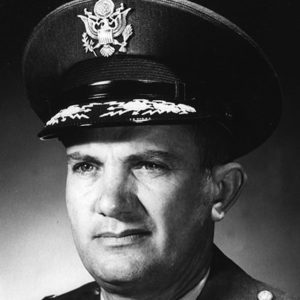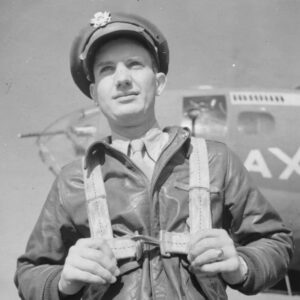calsfoundation@cals.org
Lewis Elton (Lew) Lyle (1916–2008)
A native of Pine Bluff (Jefferson County), Major General Lewis Elton Lyle of the U.S. Air Force began his military flying career as a B-17 bomber pilot in the European Theater during World War II. He flew more combat missions than any other lead pilot and was one of the war’s most decorated aviators.
Lewis Lyle was born on June 22, 1916, to Lewis Eley Lyle and Nellie West Lyle in Pine Bluff; he had a younger sister. After graduating with honors from what is now Ouachita Baptist University in 1938, he was commissioned as a second lieutenant in the U.S. Army Infantry Reserve. He began active duty in December 1940 as an anti-tank company officer. In May 1941, he was selected for Aviation Cadets training and was awarded his Army Air Corps wings in December 1941. After the bombing of Pearl Harbor—and upon activation on January 28, 1942, of the Eighth Bomber Command of the U.S. Army Air Force (re-designated the Eighth Air Force in February 1944)—he was assigned to the newly formed 303rd Bomb Group (a.k.a. the Hells Angels).
He arrived in England in October 1942 to fly B-17 bombers in combat against German targets from airbases at Molesworth and Kimbolton, England. He would eventually command both the 303rd Bomb Group and the 379th Bomb Group during World War II. He flew three consecutive combat tours and did not return to the United States until after the war ended.
During the war, he flew more combat missions than any other lead pilot, and he was officially credited with sixty-nine bombing missions plus “others non-credited.” Unofficially, he flew at least seventy-six combat bombing missions. The unofficial number resulted from Lyle’s practice as a squadron commander of going to the flight line just before a bombing mission departed and replacing a crew member on a B-17 with himself. The replaced crew member received official credit for the mission even though Lyle was flying in his place aboard the aircraft. His commander at the time stated years later that he was unofficially aware of what Lieutenant Colonel Lyle was doing, but officially he knew nothing about it.
Lyle married Betty Mae Mobley in September 1945; they had a son and a daughter. He remained in the U.S. Air Force until his retirement in July 1967 at the rank of major general. His postwar military assignments and accomplishments include founding the Air Force Human Resources Research Institute (a part of the Air University System in Montgomery, Alabama) and serving as commander of the first Strategic Air Command (SAC) jet combat wing (RB 45 Tornado jet bombers), which included two bomber divisions and one missile division. He was a rated command pilot with over 7,000 flying hours, a rated senior missileer, and director of maintenance and engineering for the U.S. Air Force at Wright Patterson Air Force Base.
Lyle was awarded twenty-three combat medals, including the Distinguished Service Cross, Distinguished Service Medal, Silver Star with two oak leaf clusters, Legion of Merit, Distinguished Flying Cross with three clusters, Bronze Star, Air Medal with nine clusters, British Distinguished Flying Cross, French Croix De Guerre, and Distinguished Unit Combat Service Award, as well as five Theatre Service Ribbons. He was also inducted into the Arkansas Aviation Hall of Fame.
In 1983, Lyle formulated a plan and directed the effort to build a museum and memorial to commemorate the men and women of the Eighth Air Force. After years of work, the National Museum of the Mighty Eighth Air Force was opened in 1996 in Pooler, Georgia. He was also the founder of the World War II Aviation Memorial Wall at the Air Force Academy. Bearing his name are both the Lewis E. Lyle Rotunda at the National Museum of the Mighty Eighth Air Force and the M/Gen Lewis E. Lyle Conference Room of the 303rd BG(H) “Might in Flight” building at the Joint Intelligence Operations Center Europe (JIOCEUR) Analytic Center Joint Analysis Center at Royal Air Force Molesworth in the United Kingdom.
Lyle died on April 6, 2008, in Hot Springs (Garland County) and was buried on June 5, 2008, at Arlington National Cemetery with full military honors.
For additional information:
379th Bombardment Group H Anthology, Vol. 1: November 1942–July 1945. Paducah, KY: Turner Publishing Company, 2000.
“Lewis E. Lyle.” Military Times Hall of Valor. http://valor.militarytimes.com/recipient.php?recipientid=23107 (accessed October 22, 2020).
“Lewis E. Lyle.” United States Air Force Military Heritage Database. http://www.8thairforce.com/44thbg/search/legacy.asp?perIdentification=574 (accessed October 22, 2020).
“Major General Lewis Lyle.” U.S. Air Force. http://www.af.mil/AboutUs/Biographies/Display/tabid/225/Article/106411/major-general-lewis-e-lyle.aspx (accessed October 22, 2020).
Charles Martin
Hensley, Arkansas
 World War II through the Faubus Era, 1941 through 1967
World War II through the Faubus Era, 1941 through 1967 Lewis Lyle
Lewis Lyle  Lewis E. Lyle
Lewis E. Lyle 




Comments
No comments on this entry yet.